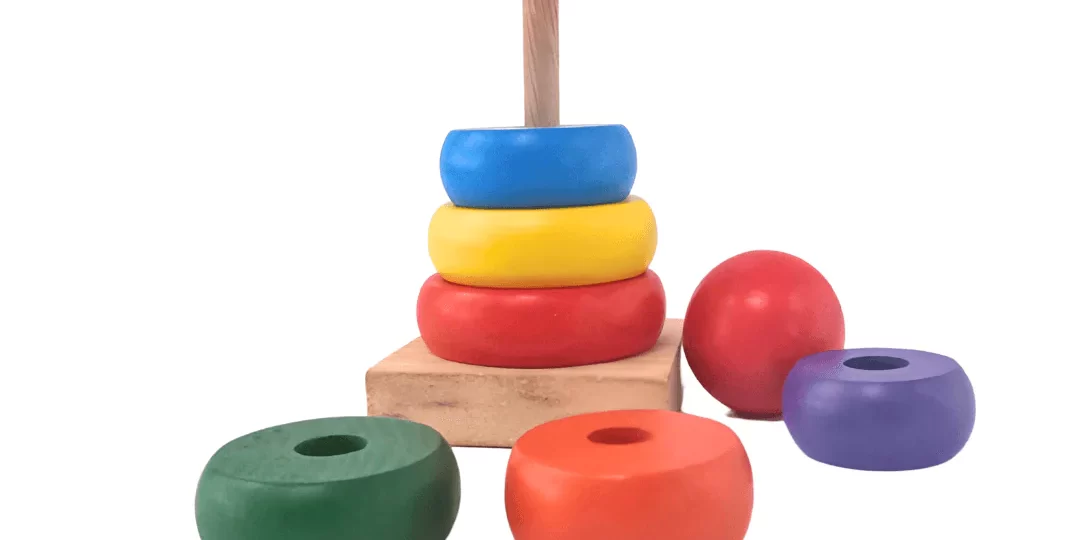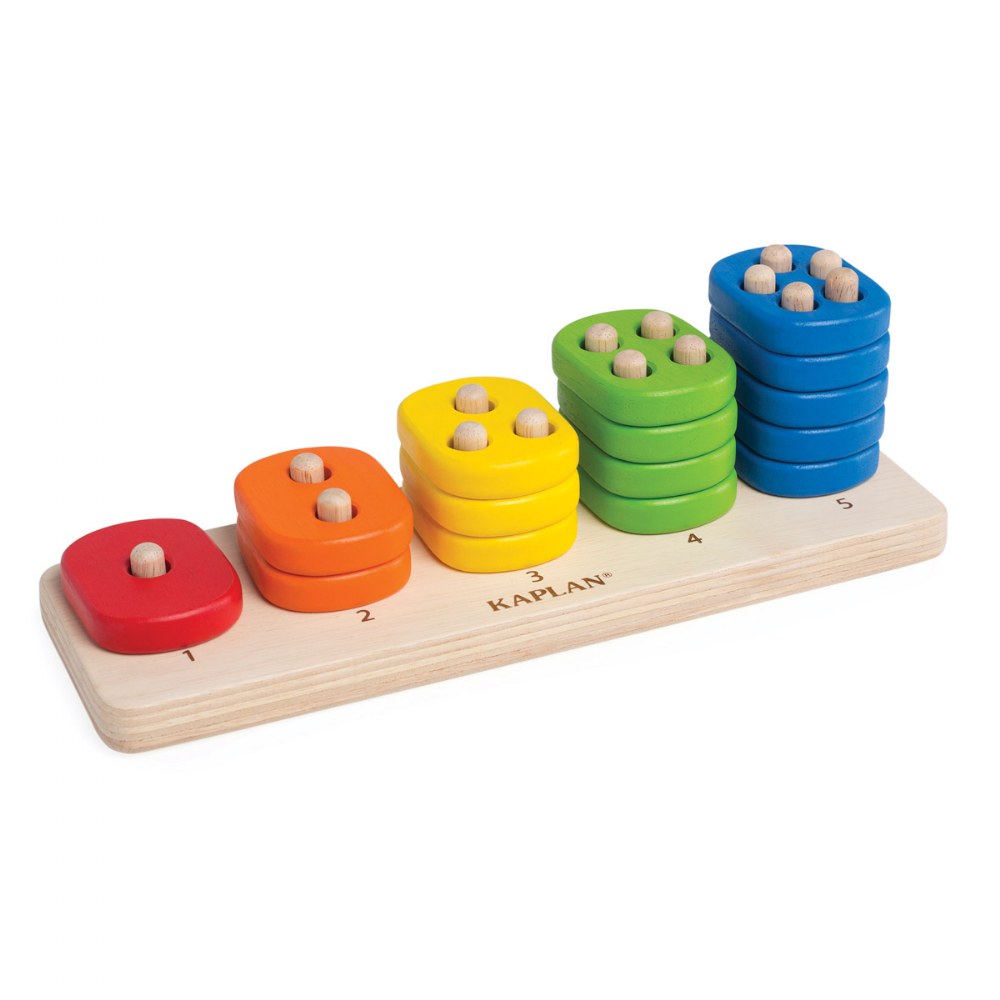
Stacking Toy Toddler Guide: Smart Play Essentials
Benefits of Stacking Toys for Toddlers
Stacking toys offer a world of benefits to toddlers as they grow and develop. These toys are brilliant tools that help improve hand-eye coordination and fine motor skills. As your toddler engages with a stacking toy, they learn to judge size and distance. This kind of play sharpens their visual-spatial understanding.
With each successful attempt at stacking, toddlers gain confidence and a sense of achievement. Their problem-solving skills get a significant boost every time they figure out which piece fits where. It’s a process that helps toddlers understand cause and effect relationships. For instance, when a stack tumbles, they learn about balance and gravity.
Language skills also get a workout with stacking toys. Parents and caregivers can use them to teach words like ‘big,’ ‘small,’ ‘up,’ ‘down,’ and color names. As they instruct toddlers to stack a specific piece, or praise their successes, they are expanding the child’s vocabulary and understanding of instructions.
Furthermore, stacking toys offer an early introduction to math concepts. Counting the blocks, discussing sequences, or sorting them by size all add up to a foundational math experience. These simple actions lay the groundwork for future numerical and categorization skills.
Lastly, stacking toys encourage patience and concentration in toddlers. These essential life skills are cultivated during play as they focus closely on balancing and arranging pieces. The repetition of stacking, unstacking, and re-stacking trains them to be persistent and to keep trying until they succeed.
In summary, a good stacking toy toddler fits into a life-learning journey—aiding fine motor development, problem-solving, language acquisition, and much more. Caregivers should consider the vast benefits of these toys when selecting play activities for their little ones.
Key Features to Look for in a Toddler Stacking Toy
When shopping for a stacking toy toddler, consider these key features to ensure you pick the best option:
- Durability: Choose toys that can withstand rough play and repeated use. Durable materials last longer and are safer for your child.
- Safety: Look for non-toxic materials and smooth edges to prevent scrapes and injuries. The toy should be BPA-free and have no small parts that pose a choking hazard.
- Educational Value: Select toys that offer more than just stacking. They should have elements that teach colors, shapes, or numbers, enhancing your toddler’s learning experience.
- Size: Pick pieces that fit well in your toddler’s hands. They should be easy to grasp, stack, and pull apart without frustration.
- Stability: Toys with a stable base help toddlers succeed in stacking without constant toppling, which can discourage them.
- Colorful and Attractive: Bright, engaging colors and fun shapes can captivate a toddler’s attention and encourage prolonged play.
- Versatility: Aim for toys that can be used in multiple ways. This may include nesting, sorting, or building, to keep playtime fresh and interesting.
By focusing on these features, you’ll be able to find a stacking toy that’s not only fun but also developmental for your toddler.
Top Stacking Toys for Different Age Groups
Choosing the right stacking toy toddler can depend greatly on the child’s age. Here’s a quick guide for different age groups:
6 to 12 Months: At this stage, go for stacking toys with large, colorful rings or soft blocks. Babies are learning to grasp and sit up, so pieces should be easy to handle.
1 to 2 Years: Toddlers in this group enjoy a challenge. Find stacking toys with more shapes or puzzles that click into place. It helps their motor skill development.
2 to 3 Years: Children at this age can handle more complex toys. Look for stackers that mix sizes and shapes or incorporate numbers and letters for early education.
3 Years and Up: Kids now have better control and understanding. Choose stacking toys that offer complex arrangements like interlocking pieces or balance games.
For each age group, ensure the stacking toy is safe, engaging and suitable for their developmental stage. This will maximize their learning and enjoyment. Remember to keep an eye on your child as they play to ensure they are both safe and making the most of the toy’s educational benefits.
How Stacking Toys Can Enhance Motor Skills
Stacking toys are exceptional for boosting a toddler’s motor skill development. These playful items engage both fine and gross motor skills. Fine motor skills involve small muscle movements. Toddlers use these when grasping and manipulating the pieces of stacking toys. Gross motor skills, on the other hand, are larger movements. They come into play when toddlers squat or stretch to stack higher.
Let’s break down how stacking toys can specifically enhance these skills:
- Hand-Eye Coordination: Toddlers learn to coordinate their vision with their hand movements. This vital skill is practiced as they aim to stack pieces accurately.
- Dexterity: By picking up, holding, and stacking, toddlers improve their finger and hand dexterity. This helps them handle objects with more precision over time.
- Grasp and Release Control: A stacking toy toddler requires a delicate balance of grip. Too loose, pieces slip; too tight, they can’t adjust. Toddlers master this through repetitive play.
- Spatial Perception: Understanding where pieces should go in relation to each other helps toddlers develop spatial awareness. This is crucial for tasks like writing and dressing.
Each stacking challenge that a toddler encounters sharpens their motor skills a bit more. As they age and their abilities grow, they can tackle more intricate stacking toys. Always aim for age-appropriate toys to match their skill level. This ensures they’re challenged just enough to learn without becoming overly frustrated.
In sum, stacking toys are much more than just fun; they are an investment in your toddler’s developmental prowess. These toys pave the way for skill sets that will be essential throughout their lives.
Incorporating Educational Elements with Stacking Toys
When selecting a stacking toy toddler, it’s vital to integrate educational components. This enriches playtime and turns it into a learning experience. Let’s explore how you can blend education with fun through stacking toys.
- Color Recognition: Choose toys with a variety of bright colors. Name each color as your toddler stacks, reinforcing color knowledge.
- Shape Learning: Opt for stacking toys with different shapes. This teaches toddlers to recognize and differentiate between shapes as they play.
- Counting Skills: Many stacking toys come with a number of pieces. Use them to help your child practice counting as they add or remove pieces.
- Letter Awareness: Some stacking toys include pieces with letters. These are great for introducing the alphabet in a tactile, engaging manner.
- Pattern Building: Encourage toddlers to stack in specific sequences. This can lay the foundation for understanding patterns and sequences later on.
By incorporating these educational aspects, stacking toys become powerful tools in your toddler’s development. Not only do they provide hours of play, but they also foster learning that sticks. It’s a win-win situation for their growth and entertainment.
Safety Considerations When Choosing Stacking Toys
Choosing the right stacking toy toddler involves important safety considerations to keep in mind. Here are some tips for selecting safe stacking toys for little ones:
- Non-Toxic Materials: Ensure the toys are made from non-toxic materials. Toddlers often put toys in their mouth, so this is crucial.
- Smooth Edges: Rounded, smooth edges are essential to avoid injuries from sharp corners. Always feel the toy’s edges before purchasing.
- Size of Pieces: To prevent choking, pieces should be large enough that they cannot be swallowed. Check the recommended age range on the packaging.
- Quality Construction: Avoid toys with parts that could easily break off. Sturdy construction means safer play.
- Stable Base: A stable base is important, so the toy doesn’t tip over easily during stacking, which could hurt your child.
- BPA-Free: Look for BPA-free labels. BPA is a harmful chemical and should not be in children’s toys.
Adhering to these safety tips when choosing a stacking toy toddler can help ensure that playtime is not only educational and enjoyable but also safe for your precious little ones.
Creative Ways to Play with Stacking Toys
Stacking toys aren’t just for traditional stacking. They’re a gateway to imaginative play and creativity. Creative play with stacking toys can keep your toddler engaged for hours and can also introduce new concepts and challenges. Here are some ideas to make playtime with stacking toys even more inventive and enjoyable:
- Create stories: Use the stacked blocks or rings as characters in a story. This sparks imagination and storytelling skills.
- Mix and match: Encourage your child to mix toys from different sets. This enhances their creative thinking as they find new ways to combine pieces.
- Color sorting games: Have your toddler sort pieces by color before stacking. It’s a great way to reinforce color recognition in a fun way.
- Build and knock down: Let toddlers build a tower and knock it down. It’s a thrilling activity that teaches cause and effect.
- Time challenges: Introduce a timer and challenge your toddler to stack as fast as they can. This can improve their speed and hand-eye coordination.
- Obstacle courses: Create an obstacle course and have the child stack items at the end. This game integrates gross motor skills with stacking play.
Remember, safety comes first. Always supervise playtime and ensure the stacking toy toddler is age-appropriate. With these creative play ideas, your toddler’s time with stacking toys will be full of learning and laughter.
Maintenance, Storage, and Care for Stacking Toys
To keep a stacking toy toddler-friendly and last longer, good maintenance is key. Here’s how you can care for these toys:
- Clean Regularly: Wipe the toys with a damp cloth to clean off any dirt or spills. For deeper cleaning, use a mild soap.
- Dry Properly: After cleaning, make sure the toys dry out completely to prevent mold or mildew growth.
- Safe Storage: Store stacking toys in a dry area. Use bins or shelves to organize them and keep them easily accessible for play.
- Check for Damage: Before play, inspect the toys for any broken parts that need repair or replacement to ensure safety.
- Avoid Sun Damage: Keep these toys away from direct sunlight to prevent color fading and plastic warping.
- Teach Responsibility: Encourage toddlers to put away their toys. This helps them learn to care for their belongings.
By following these simple care steps, a stacking toy toddler can enjoy a better playtime experience. Plus, you extend the life and quality of their favorite toys.


